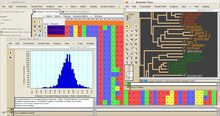Mesquite is a software package primarily designed for phylogenetic analyses. It was developed as a successor to MacClade,[1] when the authors recognized that implementing a modular architecture in MacClade would be infeasible.[2] Mesquite is largely written in Java and uses NEXUS-formatted files[3] as input. Mesquite is available as a compiled executable for Macintosh, Windows, and Unix-like platforms,[4] and the source code is available on GitHub.
 | |
| Original author(s) | Wayne P. Maddison, David R. Maddison |
|---|---|
| Initial release | March 14, 2001 |
| Stable release | 3.81
/ April 20, 2023 |
| Repository | |
| Written in | Java |
| Operating system | Macintosh, Windows, Unix-like |
| Platform | Cross-platform |
| Type | science |
| Website | mesquiteproject |
Rationale
editThe architecture of Mesquite was explicitly designed to exploit the modularity and extensibility of Object-oriented programming.[5] In practice, Mesquite modules are Java classes, usually concrete sub-classes of abstract class definitions.[6] This modular architecture has afforded the development of additional packages[7] that can be used as plug-ins to Mesquite.
Scope
editMesquite provides a number of analyses including ancestral state estimation and diversification analysis. Mesquite also contains tools for simulating data such as species trees, gene trees, and DNA matrices. The base distribution of Mesquite affords interoperability with other programs, for such purposes as multiple sequence alignment (e.g. Clustal and MAFFT), as well as the ability to retrieve DNA sequence data from GenBank. Mesquite includes some rudimentary tools for phylogenetic tree estimation; however, the Zephyr[8] package provides a Mesquite interface for interacting with other phylogenetic inference programs including RAxML,[9][10] PAUP*, and GARLI.
External links
editReferences
edit- ^ D. R. Maddison & W. P. Maddison. "MacClade". Retrieved 2016-03-11.
- ^ "History of Mesquite". Mesquite Project. Retrieved 2016-03-11.[dead link]
- ^ Maddison D.R.; Swofford D.J.; Maddison W.P. (1997). "NEXUS: an extensible file format for systematic information". Systematic Biology. 46 (4): 590–621. doi:10.1093/sysbio/46.4.590. ISSN 1063-5157. PMID 11975335.
- ^ "Mesquite Installation". Mesquite Project. Retrieved 2016-03-11.[dead link]
- ^ "Why Mesquite?". Mesquite Project.[dead link]
- ^ "How Mesquite Works". Mesquite Project. Retrieved 2016-03-11.[dead link]
- ^ "Additional Mesquite Packages". Mesquite Project. Retrieved 2016-03-11.[dead link]
- ^ Maddison D.R.; Maddison W.P. "Zephyr". Retrieved 2016-03-11.
- ^ Stamatakis A. "RAxML: Randomized Axelerated Maximum Likelihood". Retrieved 2016-03-11.
- ^ Stamatakis A (2014). "RAxML version 8: a tool for phylogenetic analysis and post-analysis of large phylogenies". Bioinformatics. 30 (9): 1312–1313. doi:10.1093/bioinformatics/btu033. PMC 3998144. PMID 24451623.